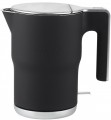The design in which the electric kettle is decorated. In addition to
the classic design, nowadays there are more original styles, namely:
—
Retro. Devices stylized antique — mainly for kitchen utensils of the 30s — 50s of the XX century. The degree of stylization in this case can be different: for example, some appliances are not different from ordinary kitchen kettles that are placed on the stove. Also note that almost all samovars are performed in retro style (see "Type"). But thermopots and teapots in this design are almost never produced. Anyway, a retro kettle will be indispensable for a kitchen in the same style, but it can also fit into a modern interior.
—
Hi-tech. The devices that have a technological, sometimes even futuristic design — using unpainted metal, transparent glass, as well as a minimal amount (or even complete absence) of decorative details. At the same time, the design can be quite unusual: for example, there are models that taper upward and vaguely resemble laboratory flasks. Like the retro style, almost no other devices are produced in this style other than classic kettles.
When choosing a device in a specific design, note that the design inevitably affects the cost — sometimes quite noticeably, despite the fact that it usually does not provide functional advantages.
The power consumed by the kettle during operation is actually the power of the heating element installed in the device.
Two working moments depend on this parameter: heating intensity and electricity consumption. On the one hand, the
high power of the heater allows you to quickly heat up a certain volume of water and saves time. On the other hand, the power consumption of such a device will also be appropriate. The wattage of a kettle's heater typically does not have a significant impact on electricity bills since the energy consumption required to heat a given volume of water remains the same regardless of the heater's power rating. However, there may be certain issues related to electrical connectivity. For example, if the wiring is weak or the fuses are improperly sized, the operation of a high-power heater may cause power outages. Additionally, devices with a power rating greater than 3500 W cannot be connected to a regular electrical outlet and require a specific power format. Consequently, even the largest thermal pots, which typically have a capacity of 10 L or more, are rarely equipped with heaters more powerful than 3000 W, since this power rating is sufficient for their intended use and can be connected to a standard electrical outlet.

